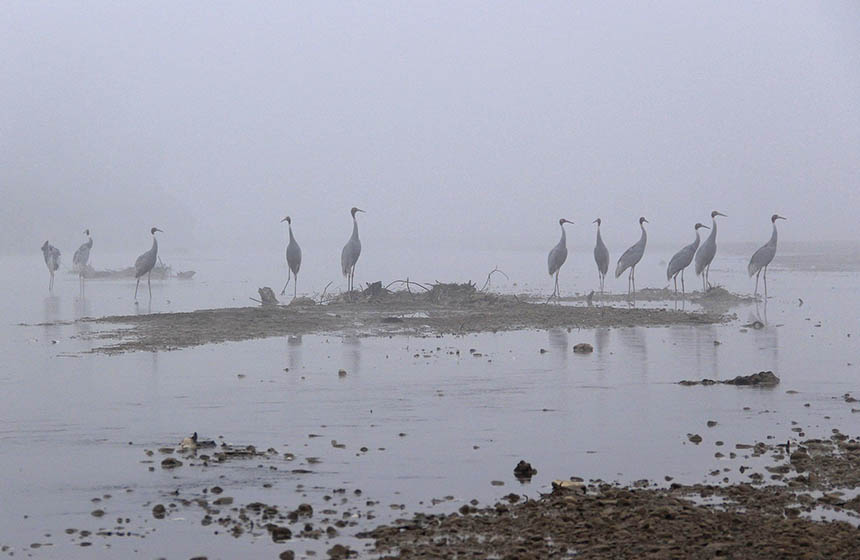Organic farming, conservation, and restoration in a wetland ecosystem
The Alliance for Integrated Development (AID-Nepal) works to protect and manage the resources of Nepal’s largest human-made wetland ecosystem. Organic farming and restoration efforts conserve biodiversity in the area, of birds in particular, and support sustainable livelihood options.
Nature-based Intervention:
The Alliance for Integrated Development (AID-Nepal) works to maintain biodiversity in the Jagadishpur wetland and create sustainable livelihood options for surrounding communities. The main activities implemented include organic farming, riverbank restoration and reforestation, anti-poaching, sustainable livelihoods, and developing ecotourism. The organic farming practices implemented focus on reducing reliance on chemical fertilisers and integrated pest management, providing technical, in-the-field training to support the implementation of these practices. These efforts all serve to support sustainable livelihood options for surrounding communities and have a particular focus on conserving the variety of birdlife in the wetland, including endangered vultures and cranes.
Overview of context and outcomes:
The Jagadishpur wetland is the largest human-made wetland area in Nepal covering an area of 2.25 square kilometres. It was initially constructed in 1972 for irrigation purposes but was later declared a Ramsar site in 2003. The wetland provides important ecological functions and serves as habitat for wildlife, especially birds, while also harbouring water to irrigate more than 6,200 hectares of surrounding agricultural land. The integrity of the wetland is threatened by overexploitation through sand extraction, poaching, land conversion, deforestation, water pollution from inorganic agricultural runoff, and invasive alien species. Furthermore, the wetland is classified as being in a “submerged succession stage,” a stage in a natural transition of open water to swamp to dry woodland. Although part of a natural transition process, this risks disrupting the water security of surrounding farms.
Case effectiveness on
Climate change
Although not quantified, the restoration of the wetland contributes to improving local water management necessary for adaptation to climate-related stresses.
Ecosystem health
Ecological effect: PositiveThe growth of an invasive alien species is reported to have been controlled. Endemic bird populations have reportedly been restored. The restoration of wetland habitats has reportedly restored important ecosystem services. Water pollution from agricultural run-off has reportedly been reduced.
Socioeconomic outcomes
Food security, income from organic farming, and the sale of medicinal plants have all reportedly increased as a result of AID-Nepal’s work. Less resources are also being invested in chemical inputs reducing costs for farmers. A reported achievement of the project has been the inclusion of Muslim women who are usually marginalised from participation in public life. AID-Nepal has provided training in participatory wetland conservation, organic farming, and integrated pest management.
Governance
The AID-Nepal programme is governed by an elected Executive Committee which manages the project.
Finance
The project has received financial support from the Niglihawa Village Development Committee, the National Lake Conservation Development Committee and the UNDP.
Monitoring and evaluation
A bird monitoring project has been put in place as well as an innovative strategy where local youth and community Wetlands User Groups team up to have the children to record the names of species they find in the wetland and report these the user group for monitoring and evaluation activities.
Trade-offs and limitations
No information yet available on tradeoffs.
Conducted at landscape scale
Ecosystem type
- Aquatic production
- Streams, rivers, riparian
- Terrestrial production
- Wetlands
Climate change impacts addressed
- Drought
- Freshwater flooding
- Reduced water availability
Instigators
- National environment and development organization
Societal challenges
- Biodiversity conservation
- Climate change adaptation
- Disaster risk reduction
- Economic and Social development
- Rights/empowerment/equality
- Food security
- Water security
Outcomes
- Food security: Positive
- Water security: Positive
- Health: Not reported
- Local economics: Positive
- Livelihoods/goods/basic needs: Not reported
- Energy security: Not reported
- Disaster risk reduction: Positive
- Rights/empowerment/equality: Positive
- Conflict and security: Positive
- No. developmental outcomes reported: 7
Resources
Read resource 1Literature info
- Grey literature




